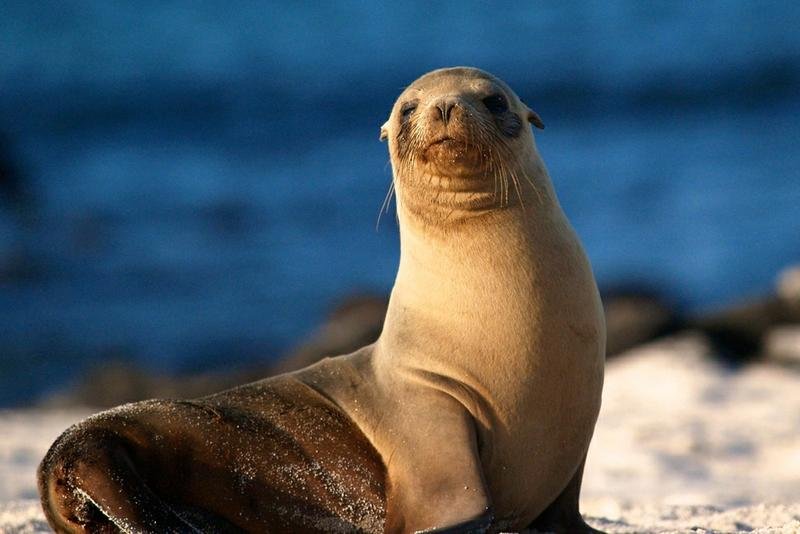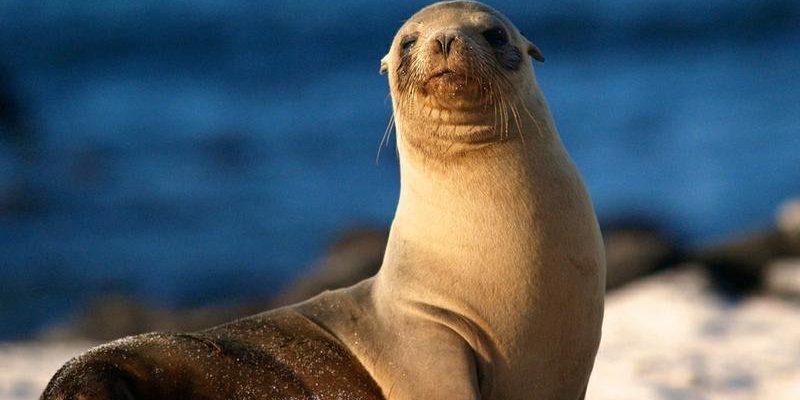
Have you ever watched a sea lion slide gracefully off a rock into the ocean? These playful creatures are not only adorable but also incredibly fascinating. Sea lions are marine mammals known for their social behavior and agility in the water. Imagine a dog, but one that lives at sea and can dive deep— that’s a sea lion for you! They are often seen basking on beaches or rock formations, delighting visitors with their curious antics.
There are several species of sea lions, but the most commonly recognized are the California sea lion and the Steller sea lion. Each has its own unique characteristics, yet they share many traits that make them stand out in the animal kingdom. Whether it’s their vocal “barking” or their impressive swimming abilities, sea lions leave quite an impression wherever they go.
Physical Characteristics
Sea lions are known for their distinctive features, which make them easily identifiable. They possess external ear flaps, unlike seals, which have only ear holes. Adult sea lions typically have thick necks and streamlined bodies that allow them to swim swiftly through water. Males are considerably larger than females, with some species exhibiting impressive manes akin to a lion’s mane.
To give you a better idea, let’s break down some key physical characteristics of sea lions:
| Characteristic | Details |
| Size | Adult males can grow up to 8 feet long, while females are generally smaller, reaching around 6 feet. |
| Weight | Males can weigh between 600 and 800 pounds, while females usually weigh around 200 to 250 pounds. |
| Color | They often have a light brown to dark brown fur, which can appear yellowish in the sun. |
| Lifespan | In the wild, sea lions typically live for 20 to 30 years. |
Overall, their impressive size and sleek bodies make them well-adapted for life in the ocean. This is where things get interesting: sea lions can dive to depths of nearly 600 feet in search of food, showcasing their remarkable physical capabilities.
Habitat and Distribution
Sea lions are primarily found along the coasts of the Northern Hemisphere, particularly the Pacific Ocean. If you’re someone who enjoys visiting the beach, you might have spotted them lounging on rocky shores or sandy beaches. California sea lions, for instance, are often seen from Southern California up to Canada.
In addition to the California sea lion, the Steller sea lion roams from Alaska down to California and is the largest species in the family. These marine mammals thrive in diverse habitats, including coastal areas, islands, and sometimes even in arctic waters. They prefer environments where they can easily access food and haul out on land to rest and breed.
You might be wondering: how do they adapt to such different environments? Sea lions have a thick layer of blubber that insulates them from cold water, allowing them to thrive in various climates. Their agility both in the water and on land makes them versatile and resilient animals.
Diet and Feeding Habits
Sea lions are made for hunting and have a varied diet that includes fish, squid, and crustaceans. They are opportunistic feeders, meaning they adapt their hunting strategies based on food availability. While they may seem playful and curious, sea lions are skilled hunters that use their speed and agility to catch prey.
When it comes to feeding, it’s impressive to note how they can dive deep and hold their breath for up to 20 minutes! They often hunt in groups, which increases their chances of catching fish. This social hunting behavior is essential, especially when targeting schooling fish.
If you’ve ever seen a sea lion shake its head or flip water off its flippers, it’s not just for fun—this behavior also helps them shake off excess water to assist in regulating their body temperature after diving. Their ability to hunt effectively and their social behavior make them fascinating subjects of study within the marine ecosystem.
Social Behavior and Communication
Sea lions are exceptionally social creatures. They enjoy being in groups, known as colonies, where they can interact, play, and breed. If you’ve visited a colony, you might have experienced the cacophony of barking and growling sounds that sea lions make. These vocalizations serve various purposes, including attracting mates, warning off rivals, and keeping in touch with their young.
Within these colonies, sea lions have a social hierarchy, with dominant males often claiming a larger territory for mating. Males will engage in vocal displays, physical contests, and even fighting to assert their dominance. This natural behavior showcases the competitive nature of these marine mammals and their instinct to protect their lineage.
You might find it fascinating how mothers and pups bond. After giving birth, a mother sea lion can recognize her pup’s unique call, allowing them to reunite after returning from foraging. This strong maternal instinct is vital for the survival of the young, emphasizing the importance of social connections in the sea lion world.
Conservation Status
While sea lions are generally not endangered, several species face threats due to human activity. Issues such as habitat degradation, pollution, and entanglement in fishing gear pose significant risks to their populations. Additionally, climate change is affecting their food sources, making it harder for them to thrive.
Conservation efforts have been crucial in protecting sea lions and their habitats. Organizations work diligently to raise awareness about the importance of marine ecosystems and advocate for sustainable fishing practices. Many coastal areas have designated marine protected zones to help safeguard the habitat of these playful creatures.
It’s essential to remember that the health of sea lion populations often reflects the overall health of marine environments. If we take care of our oceans, we can help ensure that sea lions continue to flourish in their natural habitats.
How to Observe Sea Lions
If you’re planning a trip to see sea lions, there are plenty of great spots along the coasts where they commonly haul out. Places like San Francisco’s Pier 39 or the Channel Islands offer fantastic opportunities for observing these animals up close. You’ll often hear their barks and see them lounging in the sun or playfully splashing in the waves.
When visiting, remember to keep a respectful distance. Sea lions are wild animals, and it’s important not to disturb their natural behaviors. Always follow local guidelines to protect both yourself and the animals. Binoculars can enhance your experience, allowing you to see their playful antics without getting too close.
Another option is joining a guided sea lion tour! These tours can provide insight into their behaviors, habitats, and conservation efforts, enhancing your experience while enjoying the beauty of marine life. How incredible would it be to learn while watching these amazing creatures in their natural environment?
FAQ
Are sea lions and seals the same?
Although sea lions and seals belong to the same family, they are different species. Sea lions have external ear flaps and a more robust body, while seals lack ear flaps and are generally more streamlined. Additionally, sea lions are known for their vocalizations and social behavior, often seen in groups, unlike most seals that prefer solitude.
What do sea lions do in the winter?
During the winter months, sea lions may migrate to warmer waters in search of food. They are known to travel significant distances for abundant food sources. In some locations, such as California, they may stay close to their breeding grounds, while in other regions, they might seek milder climates.
How long can sea lions hold their breath?
Sea lions are impressive divers and can hold their breath for about 20 minutes. While they typically dive for shorter periods, their ability to stay underwater for an extended time helps them hunt for food effectively. Their bodies are adapted for swimming, allowing them to navigate the underwater world with agility.
Do sea lions have predators?
Yes, sea lions have natural predators. Great white sharks and orcas are known to prey on sea lions in their habitats. Additionally, human activities such as fishing and pollution pose indirect threats to their survival. Conservation efforts aim to mitigate these risks and protect sea lion populations.
What is the difference between a California sea lion and a Steller sea lion?
The primary difference lies in their size and habitat. California sea lions are smaller, with males averaging around 600 pounds, while Steller sea lions can weigh up to 1,000 pounds. They also have different ranges, with California sea lions found primarily along the California coast, while Steller sea lions can be found from Alaska to California.
Can sea lions be trained?
Yes, sea lions can be trained and are often used in marine parks for educational shows. Their intelligence and social nature make them responsive to training. However, it’s essential that any training methods prioritize the well-being of the animals and promote natural behaviors.
How do sea lions stay warm in cold water?
Sea lions maintain their body heat through a thick layer of blubber that insulates them from the cold. This layer acts as a barrier against temperature changes in the water, allowing them to dive in colder environments without discomfort.
Are sea lions endangered?
While most sea lion populations are not considered endangered, specific species, such as the Steller sea lion, have faced significant declines. Conservation efforts focus on protecting these species and their habitats to ensure their long-term survival in the wild.
What do baby sea lions eat?
Baby sea lions, known as pups, primarily rely on their mother’s milk for nutrition during their early months. As they grow, they gradually transition to solid food, which includes fish and squid, learning to hunt under the guidance of their mothers.
Where can I see sea lions in the wild?
Sea lions can be seen in various coastal areas, especially in California, where they are known to haul out on beaches and rocky shorelines. Some popular viewing spots include San Francisco’s Pier 39 and the Channel Islands. Guided tours also offer opportunities to observe them in their natural habitat.
What sounds do sea lions make?
Sea lions are quite vocal, producing a range of sounds including barks, growls, and even grunts. These vocalizations serve various purposes like communication, attracting mates, or warning off competitors. Their unique sounds are part of what makes watching them such an entertaining experience.
How fast can sea lions swim?
Sea lions are speedy swimmers, capable of reaching speeds up to 25 miles per hour. Their powerful foreflippers and streamlined bodies help them move efficiently through the water, making them formidable predators while hunting for food.

